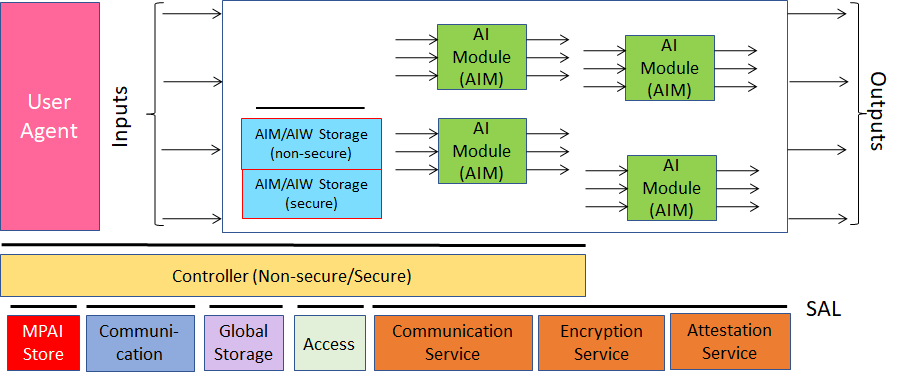(Informative)
MPAI – Moving Picture, Audio, and Data Coding by Artificial Intelligence, the international, unaffiliated, non-profit organisation developing standards for Artificial Intelligence (AI)-based data coding with clear Intellectual Property Rights licensing frameworks, develops standards in compliance with a rigorous process [2] pursuing the following policies:
- Be friendly to the AI context but, to the extent possible, agnostic to the technology – AI or Data Processing – used in an implementation.
- Be attractive to different industries, end users, and regulators.
- Address three levels of standardisation any of which an implementer can freely decide to adopt:
- Data types, i.e., the data exchanged by systems.
- Components called AI Modules (AIM).
- Connected components called AI Workflows (AIW).
- Specify the data exchanged by components with a clear semantic to the extent possible.
MPAI Standards and Technologies provides general information about MPAI standards..
Technical Specification: AI Framework (MPAI-AIF) V2 enables dynamic configuration, initialisation, and control of AIWs in a standard environment called AI Framework (AIF). Figure 1 depicts the AI Framework.

Figure 1 – The AI Framework (MPAI-AIF) V2 Reference Model
Thus, users can exercise AIWs that are both proprietary or standardised by MPAI – i.e., with standard functions and interfaces, with an explicit computing workflow. Developers can compete in providing AIMs with standard functions and interfaces that may have improved performance compared to other implementations. AIMs can execute data processing or Artificial Intelligence algorithms and can be implemented in hardware, software, or hybrid hardware/software.
AIW and its AIMs may have 3 interoperability levels:
Level 1 – Proprietary and satisfying the MPAI-AIF Standard.
Level 2 – Specified by an MPAI Application Standard.
Level 3 – Specified by an MPAI Application Standard and certified by a Performance Assessor.
MPAI offers Users access to the promised benefits of AI with a guarantee of increased transparency, trust and reliability as the Interoperability Level of an Implementation moves from 1 to 3.
As manager of the MPAI Ecosystem specified by Technical Specification: Governance of MPAI Ecosystem (MPAI-GME) [3], MPAI also ensures that a user can:
- Make use of a reference implementation of a Technical Specification, by providing a Reference Software Specification with associated software.
- Test the conformance of an implementation with the Technical Specification, by providing Conformance Testing Specification.
- Assess the performance of an implementation of a Technical Specification, by providing the Performance Assessment Specification.
- Get conforming implementations, possibly with a performance assessment report, from a trusted source through the MPAI Store.
MPAI Calls “Standard” the combination of Technical Specification, Reference Software Specification, and Conformance Testing Specification. The MPAI-AIF V2 Technical Specification will be accompanied by a Reference Software Specification and a Conformance Testing Specification.
The chapters and the annexes of this Technical Specification are Normative unless they are labelled as Informative. Terms beginning with a capital letter are defined in Table 1 if specific of this MPAI-AIF Technical Specification, or in Table 2 is used across MPAI Standards.

